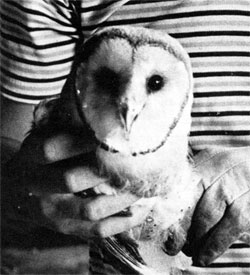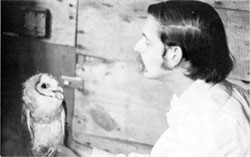Birds Find Haven at Fermilab
Endangered barn owls are finding sanctuary in the shadow of Fermilab's accelerator.
About a month ago, three fledglings were placed in an abandoned barn on site. From a manmade nest, they were fed until they could fly and find food on their own. Scientists are monitoring their movements with small radio transmitters banded to the birds.
Cooperating in the owl restoration program are: Fermilab; Lincoln Park and Brookfield Zoos; the Fox Valley Park District's Red Oak Nature Center, North Aurora; and the Illinois Endangered Species Board.
Tom Maechtle, nature center naturalist, is conducting the project. "These owls," he said, "should form their own hunting territories. We hope to see them eventually breeding in the same barn or local vicinity." From a blind set up in the barn, the birds' movements are being recorded in detail.
"From these notes we hope to gather information on the social behavior of barn owls and other raptors," Maechtle said. "I'm sure we will discover methods that will improve our repopulation attempts in following years."
State conservation officials say no more than three or four barn owl sightings are reported annually. Their decline is due to loss of habitat, pesticides and man, who believes that they prey on barnyard fowl.
Called nature's most efficient mousetraps, barn owls each eat about 1,000 rats and mice per year.
Fermilab's owls were hatched from domestic eggs at Brookfield and Lincoln Park Zoos. Placed on site, they were fed a natural diet via a trap door until they were old enough to venture out at will. Additional releases onsite are planned; they are expected to return each Spring to breed. In about two years, scientists expect breeding will take place among the released owls.
Maechtle said adult barn owls, also called monkey-faced owls, weigh two pounds and have wingspreads of up to 30 inches.





